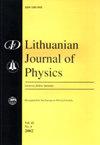用阶梯束化氮化铝层的阶梯流形态改性降低表面粗糙度
IF 0.3
4区 物理与天体物理
Q4 PHYSICS, MULTIDISCIPLINARY
引用次数: 0
摘要
传统的氮化铝(AlN)模板制造技术,如氢化物气相外延或在图案蓝宝石衬底上生长AlN,通常会导致阶梯聚束模板表面。由此产生的宏步导致在这种AlN模板上制造的紫外发光二极管(UV LEDs)的发射展宽甚至多峰特性。为了减少这些宏观步骤并提供更光滑的表面,即使不需要厚AlN沉积,这里报告了两层生长过程。三维(3D) -二维(2D)顺序生长启动了先前AlN表面形态的显着改变,同时限制了不断变化的拉伸应变。通过两层生长过程,成功地将表面粗糙度均方根为1.8 nm的阶梯聚束表面减小到0.8 nm,而没有任何薄膜开裂。在AlN厚度仅为1.3 μm的情况下,粗糙度降低了50%以上。由于表面光滑,紫外LED结构的电致发光特性得到了实质性的改善。而不是双峰发射,典型的发光二极管生长在台阶束模板,单峰发射和较低的光谱宽度实现,表明两层技术在提高性能方面具有很高的潜力。本文章由计算机程序翻译,如有差异,请以英文原文为准。
Reduction of surface roughness by modification of step-bunched aluminum nitride layers towards step-flow morphology
Conventional aluminum nitride (AlN) template fabrication techniques, like hydride vapour phase epitaxy or AlN growth on patterned sapphire substrates, usually lead to step-bunched template surfaces. The resulting macrosteps cause emission broadening or even multiple-peak characteristics of ultraviolet light-emitting diodes (UV LEDs) fabricated on such AlN templates. In order to reduce these macrosteps and to provide a smoother surface, even without the need of a thick AlN deposition, a two-layer growth procedure is reported here. A three-dimensional (3D) – twodimensional (2D) sequential growth initiates a significant modification of the previous AlN surface morphology and simultaneously limits the evolving tensile strain. A primarily step-bunched surface with a surface roughness root mean square of 1.8 nm is successfully reduced by the two-layer growth procedure down to 0.8 nm, without any film cracking. This distinct roughness reduction of more than 50% is achieved within an AlN thickness of only 1.3 μm. With a smoother surface, the electroluminescence characteristic of a UV LED structure is substantially improved. Instead of a double-peak emission, typical for LEDs grown on step-bunched templates, a single-peak emission and lower spectral width were achieved, indicating the high potential of the suggested two-layer technique for improving performance.
求助全文
通过发布文献求助,成功后即可免费获取论文全文。
去求助
来源期刊

Lithuanian Journal of Physics
物理-物理:综合
CiteScore
0.90
自引率
16.70%
发文量
21
审稿时长
>12 weeks
期刊介绍:
The main aim of the Lithuanian Journal of Physics is to reflect the most recent advances in various fields of theoretical, experimental, and applied physics, including: mathematical and computational physics; subatomic physics; atoms and molecules; chemical physics; electrodynamics and wave processes; nonlinear and coherent optics; spectroscopy.
 求助内容:
求助内容: 应助结果提醒方式:
应助结果提醒方式:


